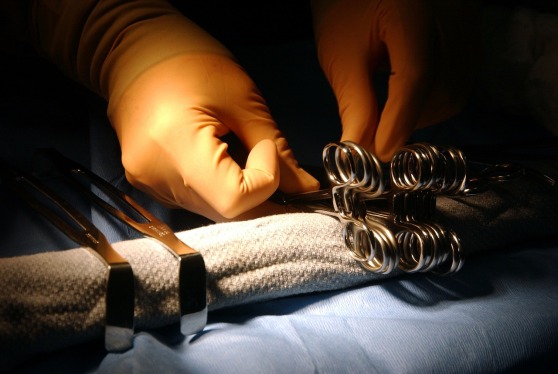By now, it should be widely understood that surgical instruments can’t be successfully sterilized if they haven’t been thoroughly cleaned first. Unfortunately, it’s a crucial step that continues to challenge many sterilize processing professionals.
1. Don’t let blood dry-Starting the decontamination procedure within 20 minutes after surgery prevents blood from drying and is your best defense against corrosion, pitting and staining. If more time is required, keep instruments moist by placing a wet towel over the equipment. The use of spray-on wetting agents (enzymatic- or detergent-based) is also an efficient way to manage instruments moist.
2. Know the adversary – Water and moisture of any type, especially blood, surgical residues and chloride-based solutions are harmful to stainless steel equipment and are the primary causes of staining and pitting. Other adversaries include surgeon’s hand scrub, household solutions, bleach, iodine-type solutions, general disinfectants, and even briny.
3. Use the right solutions – Only use solutions that have been specifically designed for use on surgical equipment for washing, disinfecting and lubricating. Their product labels will state the intended use on the label. Only solutions with a neutral pH (between 7pH and 8pH) are recommended.
4. Ultrasonically clean– Ultrasonic cleaning is the most efficient technique for cleaning difficult-to-clean areas such as box locks, hinge areas, and serrations. Ultrasonic cleaning employs millions of microscopic collapses produced from sound waves to barrage and pull away debris from the surface of the equipment. Recommended for use in automatic washers and ultrasonic machines when instruments have been pre-cleaned. Hemolytic detergent removes blood and soil, then rinses spot-free, leaving no residue
5. Use the right brush– In addition to mechanized washing, it is essential to use instrument cleaning brushes to assure instruments are adequately cleaned before sterilization. When brushing lumened or annulated equipment, it is important that the brush exit the distal end fully too effectively push out any debris (and then pull back through).
6. Lubricate– A simple, profitable way to maintain instruments and maintain against rusting is to lubricate them with a water-based, neutral pH lubricant after every cleaning cycle, before sterilization. Be assured you are not utilizing a mineral or silicone-based lubricant as these will interfere with sterilization.
7. Troubleshoot stains- The following stain trouble-shooting guide will assist you determining and further prevent instrument staining.
• Brown/Orange Stains – Most brown/orange stains are not rust. This stain color is the result of high pH surface deposits caused by any of the following: chlorhexidine usage, improper soaps, and detergents, cold-sterilization solution, baked-on blood, soaking in saline, or utilizing laundry soap.
• Dark Brown/Black Stains – Low pH (less than 6) acid stain. Maybe caused by incorrect detergents and soaps and/or dried blood.
• Bluish-Black Stains – Reverse plating may appear when two various types of metals ultrasonically proceed together. For eg., stainless steel equipment processed with chrome instruments may cause a stain color reaction. Liability to saline, blood or potassium chloride will cause this bluish-black stain to appear.
• Multi-Color Stains – Extreme heat caused by a localized “hot spot” in the autoclave.
• Light and Dark Spots – Water spots from permitting instruments to air-dry.
• Bluish-Gray Stains – Cold sterilization solution being utilized outside manufacturer guidelines.
• Black Stains – Probable exposure to ammonia.
8. Sterilization– Ever sterilize with the ratchets open. This reduces stress and prevents the box lock/ hinge field from crashing, and promotes better steam penetration. If utilizing a pan or tray, we recommend one with perforations.
Delivering on consistent and compliant sterilization procedures throughout a complex organization is not simple—especially when there hasn’t been mistake or accountability for these procedures before. Making assured that instruments used in surgery are optimally cleaned needs the expertise, quickness, and willingness to the defender for change in the face of resistance.



 Stainless Steel – One of the most helpful characteristics of this smooth, corrosion-resistant steel is its hygienic quality. Stainless steel is simple to clean and can combat sterilization methods as good as any material always invented. The steel is highly corrosion resistant and it is a common preferred of material for biomedical instills. Bhumika Surgicals is a leading
Stainless Steel – One of the most helpful characteristics of this smooth, corrosion-resistant steel is its hygienic quality. Stainless steel is simple to clean and can combat sterilization methods as good as any material always invented. The steel is highly corrosion resistant and it is a common preferred of material for biomedical instills. Bhumika Surgicals is a leading  Temperature resistant up to 400°C, it can be disinfect at 180°C. Almost as secure as carbon steel, Inox is a magnificent general-purpose alloy for surgical operation table instruments.
Temperature resistant up to 400°C, it can be disinfect at 180°C. Almost as secure as carbon steel, Inox is a magnificent general-purpose alloy for surgical operation table instruments. Titanium – 100% anti-magnetic, corrosion-resistant, slight and strong, Titanium alloy is excellent for biological and medical applications. Titanium has the tensile strength of carbon steel and is fully resistant to corrosion from nitric acid, chloride, saltwater, and industrial and organic chemicals. Titanium is more malleable and 40% lighter than Inox. When heated or cooled, the dimensions of Titanium alloy change less than half of what stainless steel alloys will, creating Titanium surgical instruments much more reliable. Titanium is stain-free and temperature resistant up to 430°C. Titanium tools are the excellent choice for caustic environments or MRI applications.
Titanium – 100% anti-magnetic, corrosion-resistant, slight and strong, Titanium alloy is excellent for biological and medical applications. Titanium has the tensile strength of carbon steel and is fully resistant to corrosion from nitric acid, chloride, saltwater, and industrial and organic chemicals. Titanium is more malleable and 40% lighter than Inox. When heated or cooled, the dimensions of Titanium alloy change less than half of what stainless steel alloys will, creating Titanium surgical instruments much more reliable. Titanium is stain-free and temperature resistant up to 430°C. Titanium tools are the excellent choice for caustic environments or MRI applications. Dumoxel – Developed by Dumont Tools, Dumoxel is highly resistant to sulfuric environments, hydrochloric acid, mineral and organic acids. Highly flexible, Dumoxel is 95% anti-magnetic and stain resistant. Temperature resistant up to 400°C, it can be disinfect at 270°C. Dumoxel is the most famous Dumont alloy for tools.
Dumoxel – Developed by Dumont Tools, Dumoxel is highly resistant to sulfuric environments, hydrochloric acid, mineral and organic acids. Highly flexible, Dumoxel is 95% anti-magnetic and stain resistant. Temperature resistant up to 400°C, it can be disinfect at 270°C. Dumoxel is the most famous Dumont alloy for tools.